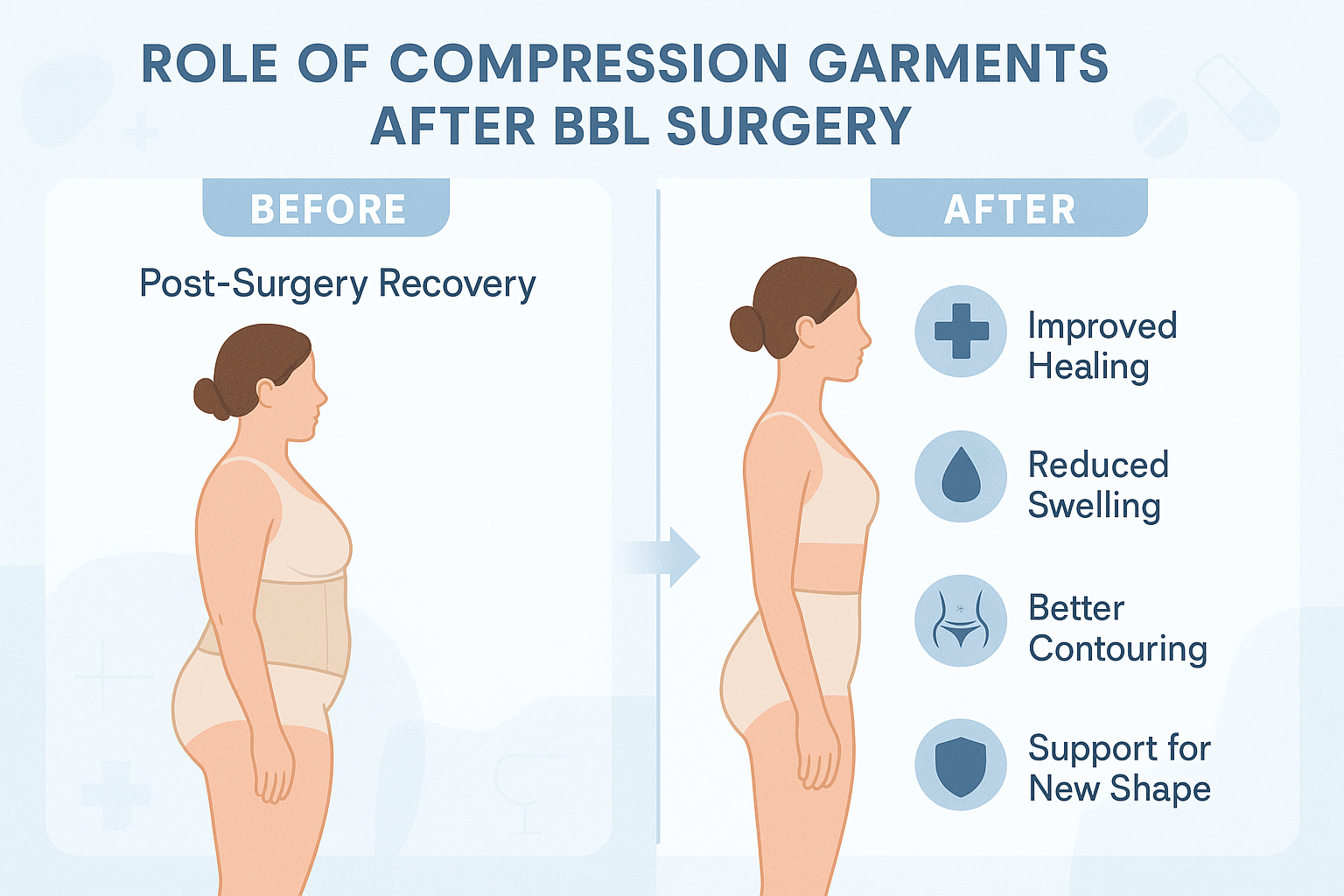The Role of Compression Garments After BBL Surgery
Planning for a Brazilian Butt Lift surgery is a life-changing process for any woman. It is not about how you look, but how you feel in your own body. As the surgical techniques and experience play a big role in your surgery, likewise, post op care is also important for preserving the best outcomes. That’s why what you do after surgery matters just as much as what happens in the operating room. Compression garments are special medical-grade garments that are put on the surgical area to provide necessary compression. In the bbl case, that must be the buttocks and the site where lipo is performed, which should be covered with these garments.
In this blog, we are going to explain what compression garments are, their benefits, and importance, with a guide on how to choose the right garment. Let’s get started!
What are Compression Garments?
Compression garments are special medical-grade apparel designed to provide controlled pressure to the surgical site. These garments are made from elastic material like nylon or spandex. The purpose of compression garments is to reduce swelling, improve blood circulation, and support the healing tissues. Compression garments come in different sizes and shapes, like gloves, socks, sleeves, and bodysuits.
Also Read: Your Guide to Shapewear Fajas & BBL Post Surgery Supplies
How Compression Garments Support Healing_its Benefits
Compression garments apply gentle pressure to the area where the fat is transferred, or removed, to help the body heal smoothly and quickly. Here are some benefits :
-
Reduce swelling and bruising: Compression garments provide consistent pressure, which helps the body reabsorb excess fluid to naturally minimize swelling and bruising.
-
Helps Shape and Sculpt Your Results: These garments gently mold your body, guiding your skin to conform to their new shape. It supports your curves while preventing lumps, sagging, or unevenness.
-
Reduce the Risk of Seroma: Seromas are the pockets of clear fluid that can build up inside the skin in empty spaces, especially in areas where liposuction has been performed. Compression garments provide consistent pressure, closing empty space, minimizing the risk of fluid accumulation.
-
Support Skin Retraction: Compression encourages the skin to retract smoothly to a new, contoured shape for aesthetically pleasing outcomes.
-
Enhances Comfort and Support: These garments minimize swelling, discomfort, and pain, making movement and everyday tasks more manageable and comfortable.
-
Prevention from Infection: Compression garments act as a barrier to help keep bacteria out, reducing the risk of infection and helping your body heal faster and safely.
-
Boost Confidence in Recovery: Compression garments provide a sense of security, helping you feel more "put together" during those vulnerable early days.
How long to Wear Compression Garments after a Brazilian Butt Lift?
It is difficult to highlight an exact timeline for wearing compression garments, as it depends on the extent of the procedure, individual health, and recovery rate. However, it is typically recommended to wear compression garments for 6 to 8 weeks after a BBL. Most patients are advised to wear compression garments 24/7 for the first two weeks, removing them only for showering. After that, the wearing time can usually be reduced to 12–6 hours per day as healing progresses, based on the surgeon’s advice.
Also Read: The Power of Post-Surgery Compression Garments
What Happens if You Don't Wear a Compression Garment?
Skipping compression garments after a BBL can seriously affect BBL recovery and results. Without it, you’re more likely to experience discomfort, pain, and swelling in the treated areas. It also puts you at risk for uneven or lumpy results, as the fat may not settle properly, and that could ruin the shape you went in for.
Compression garments help your skin reattach to the underlying tissue. Without that support, the chance of skin irregularities, loose skin, or even scarring also increases. And you’re more likely to develop complications like seromas (fluid buildup) or hematomas (blood pooling), which can slow healing and require additional treatment.
How to choose the right Compression Garment?
Compression garments are available in different shapes for different purposes, like for post-op surgery, everyday wear, or sport. Before purchasing any garments, consider your procedure and surgeon's suggestions. Here are some key points that must be kept in mind before buying compression garments.
1. Medical-grade Quality: All shapewear is not the same or for the same purposes. Look for medical-grade compression garments designed for post-op recovery.
2. Choose the Right Size: Your compression garment must fit snugly, not too tightly to restrict blood flow or loosely to be ineffective. Compare your measurement with the brand sizing chart to ensure the right fit.
3. Breathable Fabric: Consider compression garments that offer air flow and have moisture-wicking qualities to protect skin from irritation and allergy.
4. Ease of usage: Choose one with zips or adjustable strips that is easy to put on and take off, especially if your mobility is limited.
5. Ask Your Surgeon: Your plastic surgeon can recommend the best type and brand based on your specific needs.
The Role of Compression Socks in Recovery
During BBL recovery, your mobility and physical activities are often restricted, especially during the initial intensive healing phase. You'll spend most of your time lying down or with limited movement. While compression garment supports blood circulation in the buttocks and waist, what about your legs? Limited mobility can increase the risk of blood clotting (deep vein thrombosis or DVT) and swelling in the lower extremities, so your legs also need support.
This is where compression socks come in. Compression socks improve blood flow in legs and prevent fluid accumulation during those critical first weeks of limited movement. Many surgeons recommend wearing compression socks daily, especially on flights or during long periods of sitting, to further minimize risks and ensure smooth recovery.




